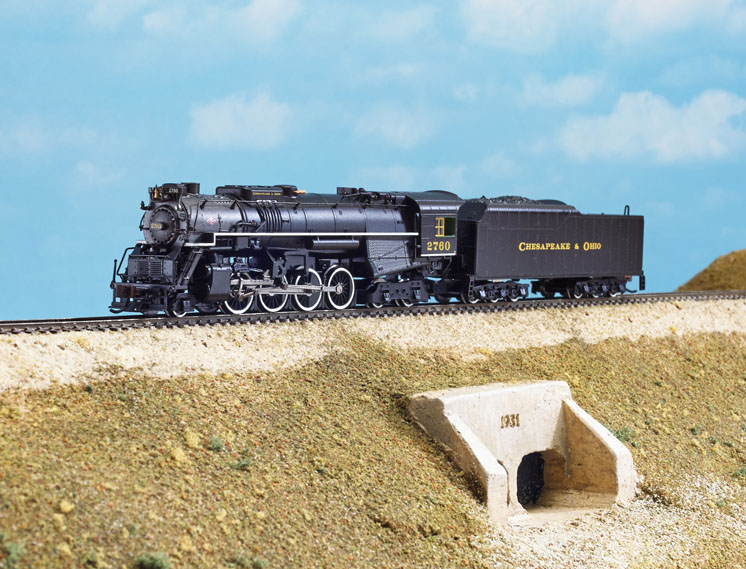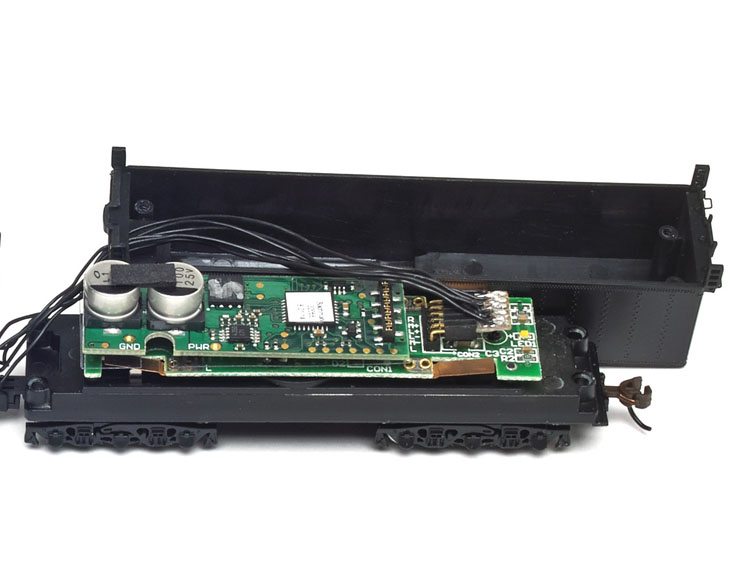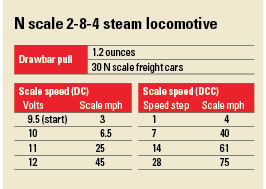The prototype. The Super Power concept developed by the Lima Locomotive Works combined design elements such as high boiler pressure and a large firebox to maximize a locomotive’s use of steam. The first non-experimental example of such a fast and powerful locomotive was the 2-8-4 Berkshire type delivered to the Boston & Albany in 1925.
The Advisory Mechanical Committee of the four major Van Sweringen-owned railroads (the Chesapeake & Ohio, Erie, Nickel Plate Road, and Pere Marquette) revised the 2-8-4 Super Power design in 1927. Starting with the Erie in that same year, all four lines would eventually roster similar 2-8-4 locomotives.
The Chesapeake & Ohio received its 90 class K-4 2-8-4s between 1943 and 1947 from both Lima and Alco. Named the Kanawha type by the C&O, the versatile workhorses hauled coal drags, merchandise freight, and protected passenger schedules during busy seasons.
The Kanawha type had a relatively short career. By the early 1950s, Electro-Motive Division F7 diesels had taken over many of the steamers’ assignments. The entire class was retired in 1957.
The model. The Bachmann 2-8-4 matches the dimensions of prototype builder’s diagrams. As with most N scale models, the oversize couplers make the total length over pulling faces 2 scale feet too long compared to the prototype.
Our review sample models C&O no. 2760, one of 25 class K-4 locomotives delivered by Alco in 1947. The model includes the spotting features that differentiated the C&O Kanawha from other Van Sweringen 2-8-4s. The placement of molded and separately applied details matches the C&O prototype. The steam dome is located behind the sand dome. The smokebox door features an oval numberplate and low-mounted headlight. The rivet pattern on the plastic tender also matches prototype photos.
Separate plastic parts include the tender ladder, throttle linkage along the engineer’s side of the boiler, and sand lines. The handrails and stanchions are separate metal parts. There’s clear glazing in all the cab windows. The boiler backhead features molded fire door detail. The vent on the cab roof is molded in the open position.
The black paint on the locomotive and tender has a smooth satin finish. The smokebox, stack, and exposed firebox are correctly painted graphite. The yellow window sashes and green interior walls are also prototypically correct. The non-functioning white classification lights on the smokebox are appropriate for an extra (non-scheduled) train or following section of a scheduled train.
The cab numbers and tender lettering are opaque and in the correct font. The tiny locomotive classification printing is so small that I couldn’t read it. It’scorrectly placed in the lower front corner of the right cab side, but according to prototype photos, it’s incorrectly placed in the rear corner of the left cab side. The diamond-shaped Lima builder’s plates are out of place for our review sample. Based on an Alco-built prototype, the model should have that firm’s distinctive rectangular builder’s plates.
Mechanism. The flywheel-equipped coreless motor is inside the split die-cast metal locomotive chassis. A gearbox is connected to the second and third driver axles. Metal side rods transfer power to the other axles. A plastic drawbar with copper electrical contacts running under it connect the locomotive and tender.
After removing four screws on the tender chassis, I easily lifted off the plastic tender shell. Six wires running from the locomotive are soldered to the main printed-circuit (PC) board. The Sound Value decoder is also plugged into a 9-pin socket on the main PC board. A downward-facing ½” diameter round speaker fits into a recess on the plastic tender chassis.
Performance. On our DCC test track the 2-8-4 started rolling at 4 scale mph in speed step 1 and accelerated to a top speed of 75 scale mph in speed step 28. Setting the decoder to 128 speed steps offers finer control, and with that setting the locomotive rolled smoothly at 2 scale mph in speed step 1.
On our DC test track, I ran the locomotive with an MRC Tech 7 power pack. The model required a lot of voltage (9.5V) to start moving smoothly at 6 scale mph. The 2-8-4 accelerated to 45 scale mph at 12V.
The model easily negotiated the 13″ radius curves and no. 6 turnouts on our Red Oak project layout. Its 1.25 ounce drawbar pull is equivalent to 30 N scale freight cars on straight and level track.
Sounds. Out of the box, our review sample emitted a sharp squeak whenever I pressed the whistle. Removing the tender shell and making sure it was seated correctly on the chassis before reassembly solved the problem.
The Sound Value decoder has the same excellent sonic qualities of a fully featured SoundTraxx Tsunami decoder. The exhaust chuffs are properly timed at four chuffs per wheel revolution. The whistle has the deep “steamboat” quality of the prototype. Both a long and short whistle blast can be triggered with function keys. Other functions include the bell, a boiler blowdown, and a headlight dimmer.
Unlike the Tsunami, the Sound Value decoder lacks an adjustable equalizer and some of the other advanced sound controls. It also doesn’t support CV61 for setting up a function key to be used as a brake to stop the locomotive. However, most of the programmable CVs are supported, including adding momentum, setting up speed tables, and adjusting individual volume levels. Using an NCE Powercab DCC system, I easily programmed CVs both on a programming track and on the main.
On a DC layout, most of the sound effects are automatic, including the exhaust chuff and the cross-compound air compressor. A forward whistle signal (two toots) sounds just before the model starts moving forward, while a reverse signal (three toots) sounds just before the model backs up. A single toot sounds when the locomotive stops and the bell rings at speeds under 20 scale mph.
The Bachmann 2-8-4 is an impressive model that captures both the look and sounds of a powerful mainline steam locomotive.
Price: $329
Manufacturer
Bachmann Trains
1400 East Erie Ave.
Philadelphia, PA 19124
www.bachmanntrains.com
Road names: Chesapeake & Ohio (nos. 2760 and 2724), Nickel Plate Road (nos. 759 and 765), Pere Marquette no. 1225
Era: 1943 to 1957 (as detailed)
Features
▪▪Coreless motor with brass flywheel
▪▪Die-cast metal boiler and chassis
▪▪Dual-mode sound decoder
▪▪Electrical pickup on six drivers and all tender wheels
▪▪E-Z Mate Mark II knuckle couplers on pilot and tender at the correct height
▪▪Light-emitting diode (LED) headlight and backup light
▪▪Metal wheels in gauge
▪▪Minimum radius: 11.25″
▪▪Traction tires
▪▪Weight: 6.3 ounces (total)
▪▪4.4 ounces (engine only)


















I was surprised that the review did not mention the excessive (non-prototypical) spacing between the drivers / trailing wheels and the boiler / cab. Check online for prototype berkshire photos and you see that this model was not done well.
White flags or lights indicate an extra train, green flags or lights indicate that there is a second (or additional, if more then one) section following. The last section would not display flags as it is the final 'part' of the train. You can't have signals meaning two different things! BTW, I double checked on this prior to posting this comment, you can verify this with Andy!
Sorry but I think this is a very low quality Loco..I have had it apart a few times since new ,4 weeks old,just to get everything working ok.(as did the mag reviewer) !!!.It still isn't 100%.. !! I have several N dcc with sound loco's & this is by far the worst !!! Sound is also very low quality & instructions are very limited.It took 4 emails to Bachmann support just to get CV's..Hopless..This is the first negative review I have done..
Wanted to add more DCC steam engines on my layout. This would make a nice addition to my fleet of engines. Have several DC 2-8-4 engines I'd like to repLace.